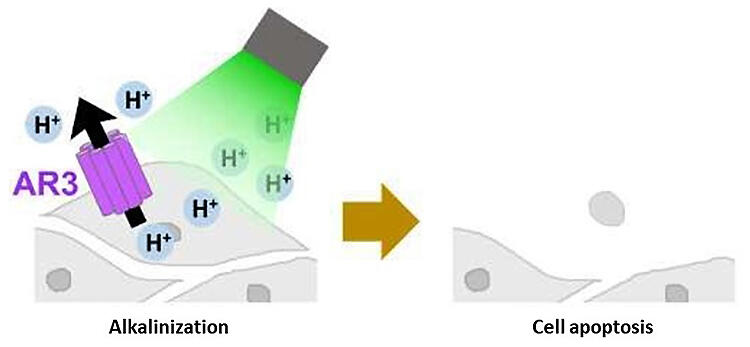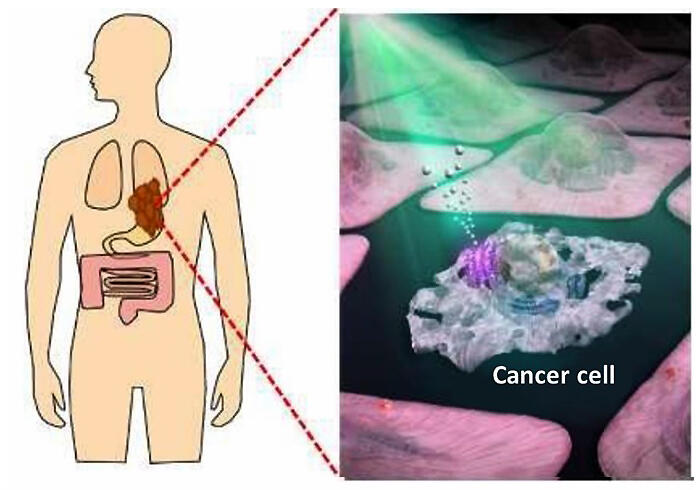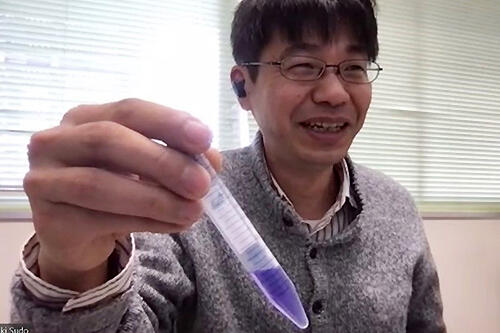Okayama University scientists work towards a novel treatment without adverse reactions
Cancer has been the leading cause of death in Japan over the past 40 years. Despite the rise in patients due to the aging population, progresses in diagnosis and treatment are leading to higher survival rates. Now, researchers at Okayama University developed a technique to induce apoptosis (self-destruction) in targeted cells using a protein that alkalizes cells when irradiated by light. Such an approach could pave the way for treatment without negative side effects.
Focusing on light-sensing proteins
When carrying out cancer treatment, it is important to make cancer cells die. The primary means of treatment tends to be drugs, and many of these share the same problem: they act not only on cancer cells but also the surrounding healthy cells, causing unwanted adverse reactions. Several light-based therapies have been developed, centered around concentrating drugs in cancer cells and then killing them with light. In recent years, photoimmunotherapy has drawn much attention, which is a revolutionary treatment that skillfully utilizes light as well as the host's immune system.
"These methods use chemical substances and cause necrosis physically by relying on active enzymes or heat. Thus, we cannot eliminate adverse reactions no matter how much we improve them," points out Professor Yuki Sudo, who studies biophysics in the Faculty of Medicine, Dentistry and Pharmaceutical Sciences at Okayama University.

(Image provided by Okayama University and modified by JST)
The means of killing cells can be broadly divided into two categories. One is necrosis, in which cells are damaged by injury, poison, or viral infection and then die. The other is apoptosis, in which unwanted cells are actively killed to allow the body of the organism to survive. "We thought that if we could stealthily induce apoptosis in the target cancer cells using proteins rather than chemicals, we could help realize a breakthrough in cancer treatment without the accompanying side effects," explains Professor Sudo.
Professor Sudo's research group focused on archaerhodopsin-3 (AR3), which is a light-activated substance found in microorganisms living in the salt lakes of the United States. Such proteins of the rhodopsin family can absorb light and are essential for vision in vertebrates, including humans. AR3 is characterized by the ability to pump hydrogen ions out of the cell and lower its hydrogen ion concentration. As the hydrogen ion concentration decreases, the cell becomes more alkaline, and cell alkalinization can trigger apoptosis. Based on this knowledge, the research group started testing whether cells could be made alkaline enough to induce apoptosis using AR3.

(Image provided by Okayama University and modified by JST)
Toward a radical treatment method fundamentally different to conventional treatments
First, the researchers synthesized AR3 in human cancer-derived cells, which were then exposed to green light with a wavelength of approximately 550 nanometers (one nanometer equals one billionth of a meter). The cells were then alkalized by the activated AR3, and most of the cells underwent apoptosis within approximately three hours.
Next, they confirmed their approach in living creatures. First, AR3 was synthesized only on the sensory neurons of C. elegans, which is a commonly used laboratory animal. When they were exposed to green light throughout their bodies, the neurons synthesizing AR3 showed a reduced sensory response to chemicals. The hydrogen ions appeared to have been pumped out of these neurons by AR3, causing the cells to alkalize and then die. From these results, the researchers concluded that, when using AR3, light can trigger apoptosis in the targeted cells.

(Image provided by Okayama University and modified by JST)
AR3 genes have to be introduced into the cells for them to synthesize AR3. This is similar to the way the mRNA (messenger RNA) vaccine for COVID-19 works, whereby mRNA is injected into cells to synthesize the necessary proteins. Moreover, genetic markers can be used to synthesize AR3 in targeted cells only.

(Image provided by Okayama University and modified by JST)
"By using the 'light-induced cell apoptosis method' we developed, in which AR3 is synthesized only in human cancer cells, it is possible to kill the diseased cells without causing adverse reactions in the surrounding healthy cells. Some people may think that because our approach kills cancer with light, it is the same as previous methods. However, our strategy is centered around apoptosis rather than necrosis and therefore is fundamentally different. Our approach could lead to radically new treatment methods," remarks Professor Sudo.
Besides Professor Sudo, the research group included Assistant Professor Keiichi Kojima, who is also with the Faculty of Medicine, Dentistry and Pharmaceutical Sciences at Okayama University. The results were published in the online version of the Journal of the American Chemical Society on February 17th. This research is supported by the Japan Science and Technology Agency (JST) Strategic Basic Research Program and the Ministry of Education, Culture, Sports, Science and Technology (MEXT) Grants-in-Aid for Scientific Research.
A remarkable achievement for a student who didn't believe what his professor said
The effectiveness of the proposed approach has now been confirmed in both human cells and relatively simple animals used for experiments. The next step is to proceed with experiments in mammalian tissue using, for example, mice.
However, in this regard, a secret experiment conducted by a student was key. Unbeknownst to Professor Sudo, the student conducted an experiment in parallel in which the pH conditions applied to the cell were changed. pH is a measure of the hydrogen ion concentration in an environment, and is used as an index of acidity, neutrality, and alkalinity. "I thought that a test of our approach could definitely not be performed in neutral conditions", explains Professor Sudo, "Cells die when soaked in an alkaline solution and I wondered if this process could be accelerated using AR3. Thus, I experimented only at pH 9 (alkaline). However, the student also ran an experiment with pH 7 (neutral), that is to say, the conditions that normally occur within the human body."

(Taken from our online interview)
"At neutral pH, it is necessary to observe over longer periods of time when using our approach. Despite the fact that apoptosis did not occur rapidly at neutral pH, he continued to test resolutely for another three or four hours and ultimately succeeded. If our strategy works at neutral pH, it can be used to develop treatments. It is wonderful that this breakthrough was made by a student not believing what their professor said", Professor Sudo claims.
Shin Nakao is the name of the sixth-year pharmaceutical student who was the driving force behind these results. "I wanted to make the conditions applicable to patients, which cannot be done at pH 9. Thus, I tried our approach at pH 7. This happened to work, so I'm glad I tried it," he reflects modestly.
With sustainable development goals as the key guiding principles
Professor Sudo will continue his research on rhodopsin, which is based on the concept of using light for medicine. "Light is the ultimate energy source for all life, and we receive it every day. If light can be used for medicine, such approaches will be available in both developed and developing countries," he says. With the UN's SDGs (Sustainable Development Goals) as important indicators, Professor Sudo's group is particularly focused on the 3rd goal of "Ensuring healthy lives and promoting well-being for all at all ages," the 7th goal of "Ensuring access to affordable, reliable, sustainable, and modern energy," and the 10th goal of "Reducing inequality within and among countries."
It is said that Goethe, a great poet of the 18th and 19thcenturies, said on his deathbed: "Mehr Licht! (More light!)" Regardless of what the original meaning of this phrase was supposed to be, it always comes to mind whenever we hear keywords related to modern technology such as renewable energy, photocatalysis, and optical communications. Human beings, including those working in the field of medicine, have ample opportunities to resolve the issues facing them with "more light."
(KUSAKA Takeo / Science Portal Editorial Office)
Original article was provided by the Science Portal and has been translated by Science Japan.




